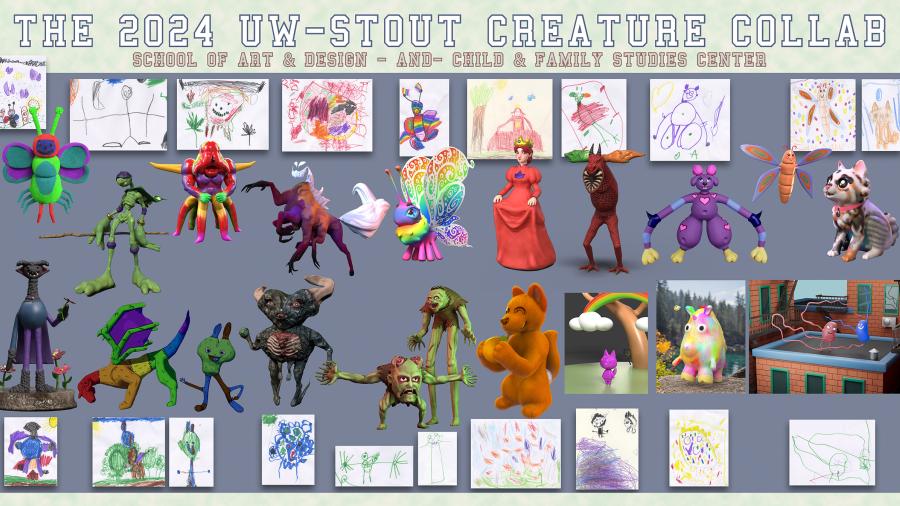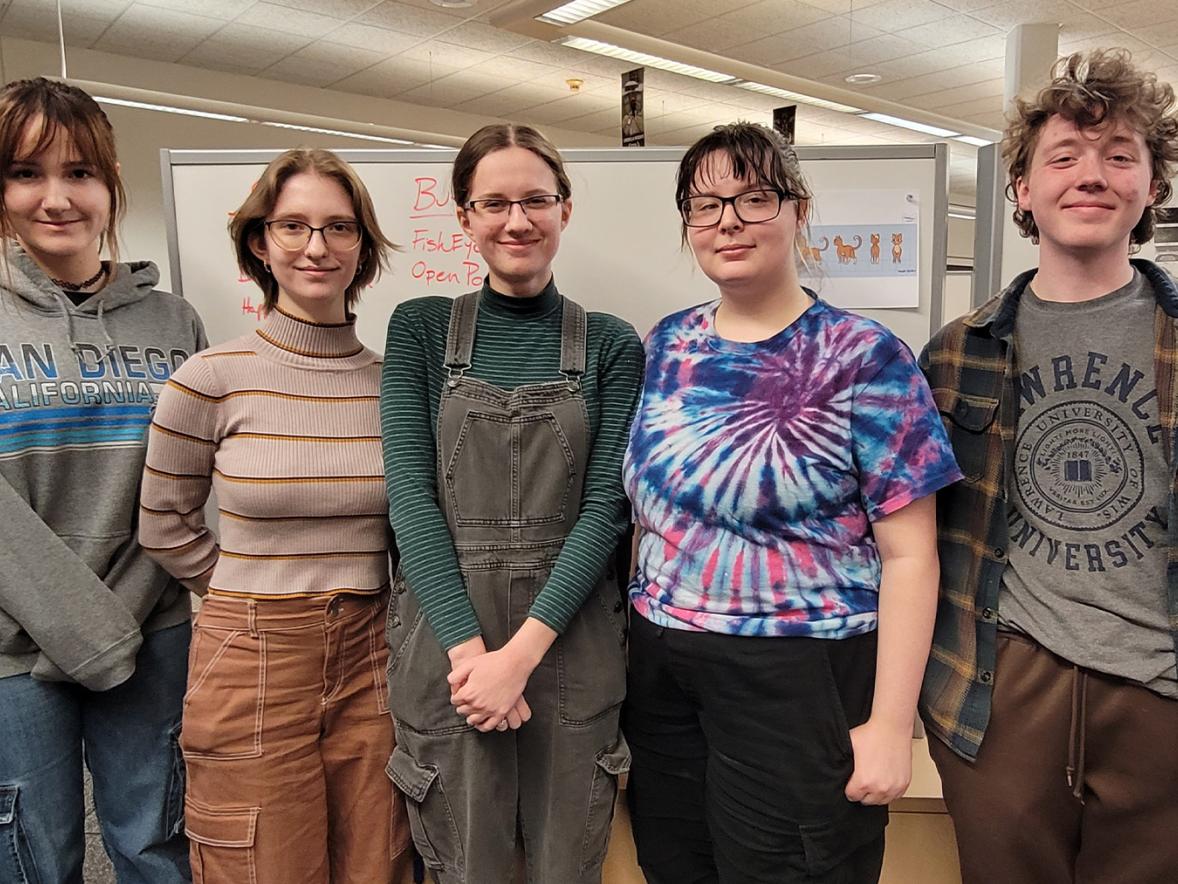Did you have an imaginary friend as a child? What if you could bring that character to life as an adult?
Animation and game design students at UW-Stout met with local children recently to bring their characters and creatures to life using 3D software.
From a purple and red butterfly to a red-eyed princess in a red ballgown, a fox holding an orange, a rainbow bunny-like creature, a kitty with a pink collar, a green monster with sweeping arms, a dragon-dog-unicorn, a brown bear, a vampire holding a flower and the warden from Minecraft.
The Creature Collaboration was between Assistant Professor Karl Koehle’s 3D Organic Modeling class and Maggie Keenan’s 4K classroom in the university’s Child and Family Study Center.
“One of the best parts of my classroom is that we are right on campus, so the children get to have these collaborative opportunities,” Keenan said. “It’s so neat that the kids helped their college partners with this project. And the children were so excited to see their drawings come to life.”
First, Koehle’s class paired off with the 17 young artists in their 4K room. While the children colored their characters, the 3D students observed, asked questions and took notes on what to include in their digital adaptations.
The children then visited their college partners in a Micheels Hall computer lab to see their character designs brought to life.
The 3D Organic Modeling class introduces students to the basics of digital sculpting tools, which mimic properties of physical clay that can be pinched, poked and pulled, Koehle explained.
“By introducing an in-person collaboration, it was my intent to give more practice to the early design process, encourage face-to-face communication with clients and offer an opportunity to embrace exploration of ideas,” he said. “It’s an important exercise to support a stakeholder who has ideas and goals but is not as adept in visual communication skills or doesn’t use the technical terminology. It's a unique design challenge to interpret meaning, then choose and apply a cohesive style.”
Carrying design skills over into their careers
In the moments before the 4K class arrived in the computer lab, the 3D students quickly made edits to their designs to brighten colors or make their characters more friendly (or less friendly, depending on the child’s original idea).
For some, it was an unexpected nerve-wracking experience. “Why am I so nervous to have children critique my work?” – “I think they’re going to love it.”
“Seeing their faces light up as we brought their creations to life was really heartwarming,” said animation senior Megan McDowell. “My favorite part was seeing how the 4Kers create and think of things. They have such big imaginations, and I loved watching them try to explain what they were thinking.”
McDowell’s 4K student had known immediately what she was going to draw – a character she named Dracula.
“This project allowed me to gain experience meeting with a client who knew what they wanted but couldn’t communicate it fully,” she said. “It allowed me to gain insight into their vision while also learning to have my own creative freedom to make design choices that I believe worked. Knowing how to use these programs and communicate with a client are skills I can carry over into my career.”
It was a challenge to design characters that resembled the children’s drawing, finding a balance between their vision while building something aesthetically pleasing that incorporated the elements of design.
“My favorite part was listening to their creativity flow. Kids can be so imaginative, as they don’t let the constraints of reality and color theory bring them down,” said game design student March Gutman.
Gutman’s 4K student’s character was Rainbow Butterfly. “It was really interesting to apply my own knowledge to the kid’s design. I would suggest anyone who has the opportunity to try and bring a kid’s illustration to life. It really makes you think outside of the box about the design process,” they said.
For game design student Alex Rowley, learning to use the Z Brush software, with its hundreds of tools and capabilities, was the biggest hurdle in creating his 4K student’s orange fox named Orangey.
The 3D students also used their time together to teach the children how to use some of the Z Brush tools to paint a princess crown, add green leaves to a tree or add an extra arm to their character.
“There is a lot to learn, especially when you’re working in programs that you’re unfamiliar with,” Rowley said. “Learning how to go through the process of ideating, modeling, sculpting, texturing and rendering will be a really important workflow for future assignments and work projects.
“It can also be quite stressful to have a young child be your boss,” he said. “It was a good way to learn how to handle opinions that may not make sense to you as an educated artist. It was also super motivating for me, specifically because the fear of disappointing a young client encouraged me to work harder.”
CFSC Director Allison Feller thinks the collaboration is a “unique opportunity where both our young learners and college students benefit. The children were able to see their ideas brought to life, while the design students applied their skills to make those ideas a reality. As the university’s early childhood education lab, we welcome opportunities to connect classroom theory with hands-on experience, which is at the heart of UW-Stout's polytechnic mission.”
The 3D students’ next step was to take the characters into Painter software, which digitally paints right on the 3D model. Koehle then printed a large-scale poster combining the children’s drawings and the 3D models, and his class presented the poster to the 4K classroom.
The collaboration marks the 10-year anniversary of a similar project between the CFSC and Professor Dave Beck’s game design class in 2014.

The Stout Game Expo will feature the works of about 250 students from 6 to 9 p.m. on Wednesday, Dec. 11, in the upper level of the Memorial Student Center. It is followed by the School of Art and Design Senior Show on Friday, Dec. 13, celebrating more than 100 seniors’ and juniors’ creative and collaborative endeavors on exhibit in Applied Arts and Micheels Hall. And the STEMM Student Expo will be from 1 to 3 p.m. on Thursday, Dec. 12, in the Memorial Student Center.
The Creature Collaboration poster may be displayed at SOAD Senior Show.
The game design and animation programs are part of UW-Stout’s School of Art and Design. SOAD also offers bachelor’s degrees in graphic design and interactive media; illustration; industrial and product design; interior design; studio art; arts administration and entrepreneurship; fashion design and development; and video production. It has a master’s in design and design, entrepreneurship and sustainability.






